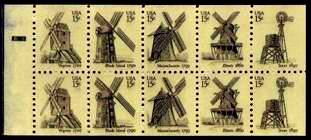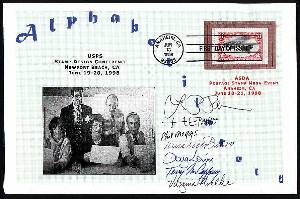Scott 1742 - Is it rail-related?

Scott 1742 - 2/7/1980
Engraved, sepia on yellow paper
This article first appeared in the November-December issue of
The Dispatcher,
the newsletter of the
Casey Jones Rail Road Unit of the ATA.
Back in mid-2003, Norm Wright, ATA Handbook Editor,
wrote to say that member Hirosuke Katsume of Tokyo (#1390), who is one of the ATA
Handbook associates, had informed him that a friend of his, a windmill expert, had run across a rail connection for
Scott 1742, shown above. He had noticed the two pictorial cancels shown below, and suggested that they showed that
windmills like the one on the stamp had been used at railroad stations in the US.


Pictorial cancels showing trackside water towers with windmills
The expert added:
Although there is no locomotive on that stamp, the windmill
and the high tank are the arrangements for a railway station.
Norm told me he had made a tentative addition to the ATA Handbook, as follows:
1742 Trackside windmill with attached tank to service
steam locomotive water stops (Texas, 1890)
I decided the "find" would make a nice story for The Dispatcher, and filed it for later. It reached the
top of
my stack of potential articles in November of 2003, so I looked around to see whether I could corroborate
the assertion.
First, the technical data. The stamps in the Windmills booklet were designed by Ronald Sharpe, and printed on
the
Giori intaglio press
by the
BEP.
They are overall tagged. Because they are considered a definitive issue,
no statistics about quantity issued are available, but we can assume that hundreds of millions were sold,
so their value today is essentially their face value. There are no known errors or significant varieties.
What about the rail connection? I started with the obvious sources. Here's what the
USPS 1980 Mint Set book for 1980 said about the issue:

Windmills Booklet, Scott 1742a, issued 2/7/1980
The distinctive designs of the five Windmill stamps reflect the evolution of windmills in America - from ideas
imported from Holland to the classic American wind machine of the Southwest United States. Featured are a post
grist type windmill in Virginia, three windmills of the smock variety, and the modern Texas-style "wind-engine".
This is the first time a US stamp booklet has contained more than one stamp design on a topical theme.
Issued Feb 7, 1980, Lubbock, Texas.
That was interesting, but it neither supported nor contradicted the rail connection. I tried the website of
Unicover, which produced and sold Fleetwood FDCs. Here is their text about the stamp:
The prairie flower's slender stem reaches skyward while the steel-petaled blossom revolves in the wind. As the
endless Texas plain recedes into the distance, this floral species becomes recognizable as an American windmill.
Invented around 1860 and used widely throughout the United States, this windmill displays a greater number of blades
than its European predecessor. Originally made of wood, but now made of metal, American wind-catchers are not as pretty,
nor as graceful as European windmills; but, they have done their jobs for over a century. These scrawny mills have drawn
water from the ground that is so valuable to the arid west that it transformed the Great American Desert into the Great
Plains. The railroads used the windmills to pump running water into their depot tanks, and ranchers used them to
irrigate their land. Windmills supplied water to salt mines in Texas and volunteer fire departments throughout the west.
At the end of a hot, dusty day on the trail, sweating cowboys chased their four-footed rivals from the barnyard tank and
cooled off in the water the windmills provided. Prairie preachers dunked repentant sinners into water tanks to sanctify
them. And, the windmills filled the waiting tanks with water that washed clothes and cooled food. Today, the western
prairies are still alive with these whirling windmills, as Americans meet an ancient challenge to capture the restless
wind.
That lent weight to the rail connection, but also implied these windmills were used many other places as well.
I searched a little farther, and found a collector page about the Texas windmill stamp, with this text:
One of a series of five windmill stamps issued by the U.S. Postal Service sometime in the 1970s or 1980s. The stamp
depicts an American farm windmill and a water storage tank. This type of wind pump is also known as a "Chicago mill" for
the region of the U.S. where hundreds of thousands were built during the 19th century.
That sort of contradicted the railroad station idea, but when I emailed the page's author to ask where he got his
information, he did not reply, and I decided his description still didn't rule out other uses.

USPS stamp design committee "on cover"
Back in 1997 I was asked to put on my
"Alphabetilately" slide show for a
group of USPS stamp designers, and got to
meet Terry McCaffrey, USPS Manager of Stamp Development. We have stayed in touch, and I decided he might have
access to some archive that could say what the source of the stamp's image was, or at least how the USPS described it
when it was issued, so I e-mailed him. He replied as follows:
Bill - I have researched your request, as best I can. But, unfortunately, the files for this project of 23 years ago
have long since been retired to the storage buildings which strongly resemble the famous storage facility from
"Raiders of the Lost Ark". Which means that we will never find these files again.
What I have found, which doesn't really help a great deal is the press release for the Windmills stamps. In it, it
states, regarding the Texas 1890 Windmill: "A Southwestern windmill, circa 1890, of the type manufactured in large
quantities around the turn of the century and used in other parts of the country as well. Also known as a "wind
machine," it was used to pump water for irrigation, drainage and for domestic use, for grinding feed and for running
light machinery."
I know this doesn't really answer your question, but that's all I have. Back in 1980, when the Bureau of Engraving
and Printing was not only printing but designing stamps, very little research or verification was done. Unlike what we
do today, where every aspect of the project is researched and documented. So, I'm afraid there is little hope in
identifying this particular windmill. Sorry.
Interesting, but as he said, it didn't answer the question.
I tried e-mailing some windmill experts, but none of them replied, so I checked some windmill and railroad images on
the Internet, and some books at the library. The conclusion I reached was this:

Windmill in Southwestern U.S. with high tank
The windmill and tank shown on the stamp could have been at a railroad station, but they could also have been on a
farm. The "high tank arrangement" would be appropriate anywhere, since the higher the tank is, the greater the water
pressure it delivers. Moreover, the
pictures I found of track-side water tanks all had cranes and pipes attached,
to deliver the water to the trains, whereas nothing of the sort is visible on the stamp. So I don't think the
stamp's image is meant to show a track-side windmill, and the most we can say is that this type of windmill was probably
used at train stations, as well as on farms and other places.
Norm Wright's decision, in the light of all the above, was to change the HB listing slightly - it now reads as
follows:
2/7/1980 Windmills
1742* Trackside windmill with attached tank sometimes used
to service steam locomotive water stops ¹ (Texas, 1890)
1 But not exclusively

Painting by T. Hosokawa
Several months after I wrote that article, I received a letter from the source of the original
suggestion, with the image above attached. He wrote as follows:
April 12, 2004
Dear Mr. Senkus,
I respect your many researches regarding Scott #1742.
And, I'm sorry to delay my response. The reason is simple. I forgot where I filed the picture
that I wanted to show you. Finally I have found it, and am attaching it to this e-mail.
I got this picture from a friend of mine, Mr.K. Koinuma. He worked once at the Tokyo Transport Museum.
This beautiful image was drawn by Mr. T. Hosokawa, a famous illustrator in Japan.
Generally, I agree with you and Mr. Norm Wright, that not all windmills and high tanks were
used for water supply to steam locomotives, but some of them were used for that.
And I think that this image is important evidence that some windmills and high tanks
were used in the rairoad stations for supplying water to steam locomotives.
Best regards,
Hirosuke Katsumi, over the Pacific Ocean
3/4/2005 - Reader Bob Campbell, of Garland, Texas, writes as follows:
I love trains and I am also a first day cover collector, as well as a stamp collector. I am developing a pretty nice
collection of train covers, if I do say so myself. Your material has been a real help and an inspiration to me. Keep up
the good work.
Although I was born and raised in Oklahoma, I have lived in Texas since 1959. So, the Texas Almanac is a familiar source
of information for me. Following is an excerpt from an article by Mary G. (Crawford) Ramos, and first published in the
1990-91 Texas Almanac.
WINDMILLS BRING WATER RELIEF
Improvement of beef herds began in earnest when windmills came to West Central Texas. The transcontinental railroads
first brought windmills to the Texas plains to provide water for their engines and crews in the early 1870s. When
ranchers were able to fence and cross-fence their lands into different pastures, they were able to control breeding, the
first requirement for improving herd quality. With a well and a windmill in each pasture, they no longer needed direct
access to a stream to provide water for their cattle. Ranchers could have separate summer and winter pastures, bull
pastures and pastures restricted to blooded stock.
With the protection of the land with wire and exploitation of the underground water supply with windmills, more high-
quality animals were imported. By the 1890s, shorthorns and Herefords were dominant.
Bill, based on the information provided in your research and this article, I am definitely adding the Texas Windmill
cover to my collection. Thanks again for all you do.
And thanks to you too, Bob.
Can any other reader add to this saga? I would welcome any further evidence one way
or the other. Can anyone find the image used for the original artwork? Reporting at the time in
the philatelic press? Tea leaf readings? All contributions are welcome - we will
publish updates here as they are received.
|











